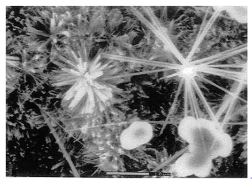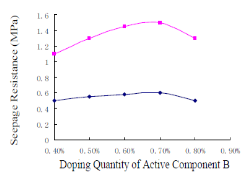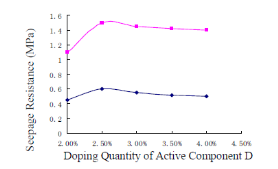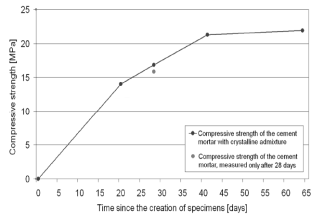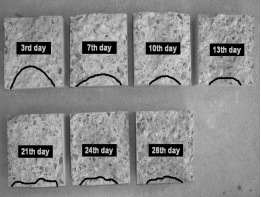Crystalline Concrete for Sub Structure Waterproofing
Crystalline Concrete for Sub Structure Waterproofing: A Literature Review
Abstract
In recent years, numerous urban areas have suffered flooding. The flood in urban area comes with even more disastrous effects such as health catastrophise in addition to damage to the properties and financial loss. The urban flood leaves behind the flooded basement of houses and other public infrastructures which needs professional attention to solve the problem. Number of techniques are available in the market for the post construction water proofing solutions. However, this review article is focused on current method of integral concrete water proofing method using crystalline waterproofing materials and preventing the sub structure flooding. This article reviews various causes of basement flooding and gives an overview of proprietary characteristics of crystalline materials such as doping quantity, influence on concrete and mortar compressive strength, degree of water tightness/impermeability, reformation of inner structural matrix etc. The benefits of using crystalline materials are illustrated followed by a case study. This literature review article revealed more favourable features of crystalline waterproofing which cannot be ignored. Crystalline waterproofing was came out as the most cost efficient and easy to operate with solution. It does not impart any significant change on the structural properties of the concrete and can be used with varied types of concrete and mortar at different locations. The crystalline concrete is meant to be the future of water proof construction industry and is currently used at many large-scale construction hydro projects to the multi-level basements of high rise structures.
Introduction
Various metropolitans and small urban areas across the world has suffered from flooding in recent years due to global warming effect. Cities across Canada are no exceptions from such disasters. Metros such as Winnipeg, Toronto, Montreal, Calgary are the victims of severe urban flood disasters. Floods causes millions of dollars damage to the country and leaves financial and health catastrophes behind. In recent years, Canada has suffered most expensive floods in the history in the City of Calgary in Alberta and Greater Toronto Area in Southern Ontario. Flood in the city of Calgary costed almost 5-Billion-dollar loss to the government with 1.7-billion-dollar loss of insured properties [1]. Numerous homes were flooded in Greater Toronto Area in July 2013 and damaged properties worth 940$ million. In 2012, Insurance bureau of Canada revealed very astonishing fact that, almost 51% claims paid to the property owners due to flooded houses were related to the basement flooding. In addition to financial catastrophes, Severity of flooded basements to the human health cannot be ignored. Damp walls and floors pooled with sewer waters are the best breeding places for various pathogens and hazardous bacteria which can lend damage to respiratory and immunity system.
There are several reasons for flooding of basements such as ground water ingress due to water table rise, infiltration of water during heavy rains, sewer back up, drainage failure, etc. which leads to deterioration of basement structure. Soil aggression due to presence of chemicals are added source of active degradation of concrete constituents [2] [3]. Such added risk of structural degradation of basement structure should be overcome by implying various changes into construction methods and post construction rehabilitation measures. By maintaining the sound structural condition of basement walls and ceiling/floor slabs, risk of basement flooding due to ground water ingress (Pluvial flooding) can be minimized. Chew and De Silva [2] carried out 61 face to face interviews and survey of 987 cases with basement flooding sue to water seepage. The severity of the problem was categorized on Likert scale on 1 to 5 scale where 1 represented “very mild”, 3 “moderate and 5 “very severe” condition. Poor joint detailing, cracks and porosity was identified as the main cause of water seepage during construction and after construction stage. I. H. Wong [3] studied the wetness of basement walls due to water seepage in various building of Singapore. it was found that in case of multi-level basement, the bottom most basement was significantly affected by moisture penetration.
Numerous techniques have been developed through years for waterproofing of sub surface walls. During construction stage, Chemicals are sprayed on structural components for damp proofing and various membrane sheets are applied on the surface post construction. All of these methods requires extensive supervision, expertise and care during the installation and there are extensive chances of system failure during the installation and due to higher hydrostatic pressure. Post construction waterproofing techniques are more complex as they are employed on late detection and hence requires excavation, temporary retention or even possibly underpinning of adjacent structures and thus such measures cannot be employed while flowing waters [4]. Most dwelling are constructed with sub surface drainages directed towards sum pits where pumps are installed to draw out percolated water to exterior sewer or storm water channels. In case of failure of pump or overflow of exterior system, drainages help water to seep through the walls.
Mechanics of Moisture Migration
Same as in the case of concrete slab, water/moisture penetrates through the walls due to hydrostatic pressure or capillary action [5]. Hydrostatic water pressure is build up due to presence of high ground water table on the backfill side of the wall. Capillary pores are developed in the soil or the wall itself. Capillary pores help water to elevate from lower to higher heights which is known as the capillary action. Concrete and especially mortar is more vulnerable to capillary action due to presence of already available micro cracks. Third but an uncommon way of the moisture migration is due to water vapour. Water in depth of soil or concrete turns into vapour due to subsequent change in the temperature. This helps vapour to travel through the sub structure walls once enough difference in the vapour pressure is established on both sides. For the prevention of moisture migration, integral crystalline waterproofing can be used with the use of chemical in the concrete mix.
Crystalline Concrete
Many researchers are working for the complete solution for a water proof concrete which can be applied during the construction process such as an additive mixture in concrete batching plant or can be used as a surface treatment method like a membrane but easy to install. However, the quest of finding an all in one solution is partially over with the development of crystalline concrete which is an integral concrete waterproofing method. The crystalline concrete waterproofing was developed in early 40’s and was designed for repairing of concrete. However, the extensive research and product development has made integral crystalline waterproofing as the future of waterproof construction industry.
This tested technology of crystalline admixture contains organic and cementitious compounds which gets activated when comes in contact with the water and reacts with unhydrated cement [4]. This reaction develops a needle like structures (As shown in Figure 1) filling the concrete pores or voids otherwise may have acted as capillary pores for the water ingress. In case if the concrete goes further cracking or crack is opened due to movement, the activated material forms crystals to fill these voids and again seals the pores. This hydrophilic admixture also helps unhydrated cement particles to stabilize through the course of time and prevents future existence of capillary pores.
|
|
|
Figure 1 Crystalline concrete needle like structures (Courtesy: The National Academic Press) |
Properties and Characteristics
The crystalline admixture is composed of Portland cement, specially treated quartz and “active chemicals”. The composition of active chemical is kept secret by the manufacturers. However, the waterproofing effect of crystalline material is confirmed in laboratory by using various chemical mixtures. Zhang Yong et al. [6] carried out experimental study to determine the quantity of the doping chemical agent to be used in concrete for crystalline waterproofing effect. Various chemical agents such as complexing agent (denoted as “B”), Calcium aluminium composite salt (denoted as “C”), Calcium hydroxide (denoted as “D”) and Calcium aluminium composite salt 2 (denoted as “E”) were used throughout the experiment. To determine the water resistivity, two seepage tests were conducted at 14 day and 28 day of casting specimen. Specimen with doping agent denoted as “D” and “B” performed the best at 14 and 28 days respectively. These two specimens were further investigated for optimization of doping quantity. Following Figure 2 shows optimization tests results for doping agents “D” and “B”. Zhang Yong et al. [6] also carried out experiments to determine the compressive strength, breaking strength and bonding strength of coating paste and observed increase of compressive and breaking strength with increase in sand-cement ratio however bonding strength decreases with increase in sand-cement ratio (See Figure 3-5).
|
|
|
|
Figure 2 Optimization test results [6] |
|
|
|
|
|
|
Figure 3 Compressive strength [6] |
Figure 4 Breaking strength [6] |
Figure 5 Bond strength [6] |
The influence of crystalline concrete admixture on the compressive strength of concrete was also studied by Pazderka[7]. The experiments were divided in to two phases, one for concrete and one for mortar. The compression resistance of concrete and mortar has been the topic of discussion since long as the elements in the substructures are designed for load bearing. The investigation of concrete compression test subjected to crystalline admixture added by 2% of cement weight showed no change in the compressive strength result of concrete cubes however, slight deceleration in the hardening process of concrete was observed. In the case of cement mortar, an increase of 25% in compressive strength was observed on 41st day of casting. Figure 6 shows the trend of growth in compressive strength of cement mortar subjected to same weight of crystalline admixture.
|
|
|
Figure 6 Growth trend of compressive strength of cement mortar [7] |
The speed of waterproofing by crystalline admixture is also a subject of claims by various manufacturers as there are no credible research has been carried out to measure the waterproofing speed of crystalline admixtures. Pazderka and Hajkova [8] studied the speed of waterproofing while using the crystalline admixtures. The experiment involved carrying out water pressure tests at different time intervals during the early hydration stage of cement. Xypex Admix C-1000 NF was used as crystalline admixture as it is widely available in the market. Cube specimen casted were subjected to 0.5MPa water pressure for 72 hours and cubes were broken to determine seepage afterwards. The test result data showed that, complete water proofing is achieved on 12th day of curing and seepage boundary was measured at 15 mm from the surface. The concrete was declared ready to carry the water load. Following Figure 7 shows seepage boundaries at various day of intervals.
|
|
|
Figure 7 Seepage shapes at various days of intervals [8] |
W. Keliang et al. [9] studied the impermeability of permeated crystalline concrete by performing impermeability tests. The results showed that use of permeated crystalline material decreases fine cracks in in the mortar matrix and reduces the distribution of pores with diameters larger than 200nm and reduced the distribution of smaller pores having diameter 20nm-100nm. This in turn reduces the most probable diameter of pores available in matrix without permeated crystalline material and hence improves water tightness. Following Figure 8 shows the distribution curve for pores with differential diameter subjected to different dosage of permeated crystalline material.
|
|
|
Figure 8 distribution curve for pores with differential diameter subjected to different dosage of permeated crystalline material [9] |
Reiterman and Baumelt [10] investigated the long-term sorption properties of concrete with crystalline admixture. It was observed that, in the initial stage of curing (7 days), the dosage of crystalline material in concrete mix does not make any change in water tightness as it retards 50% water with 0.5% and 1.0% content of crystalline material. The research suggests matured effectivity of crystalline material on 90 days and suggests past data with more than 50% and 80% reduction in capillary water transportation with same 0.5% and 1.0% content.
Crystalline mixtures can also be used as a surface treatment tool as a post construction water proofing measure. In case, the optimum thickness or depth of the crystalline cover is necessary to protect the element from further degradation. Reiterman and Pazderka [11] studied the influence of crystalline coating depth on water transport in concrete structure by electrical resistivity method, water absorption and reliability affected due to construction joints and. The researchers observed significant change in the inner formation of the concrete matrix and confirmed water tightness of the crystalline material particularly in construction joint areas.
Benefits
There are several benefits of using crystalline concrete waterproofing can be drawn from studying the literature. It can be used during construction and after construction measure. Crystalline material easily penetrates in to the concrete pores and becomes an inherent part of the concrete which cannot be detached like membrane sheets. Being a hydrophilic material, it gets activated when come to contact with water or moisture. Crystalline materials are readily available from different manufacturers and are easy to store and install. Crystalline materials can be applied on different types of concrete and mortars from outside or inside. Crystalline waterproofing is a cost effective long term solution for the substructure water proofing and hence being a successful and sustainable solution, it is increasingly used in large hydro projects around the world.
Case study: AIG headquarters London
The American International Group Inc. (AIG) is located on Fenchurch Street London. The building consists of 14 storey structure with two levels of basements. The first level was meant to host mechanical and electrical facilities and second level was supposed to be used for car parking and document storage [12]. The construction of the building was followed by a very tight time schedule and hence, the sub-contractor Duffy construction Ltd. used the integral concrete waterproofing technique and saved a moth. Pudlo concentrated integral concrete waterproofing powder was used with C40 grade of concrete, cement content of 350 Kg/m3, water/cement ratio of 0.4 and slump height was 100mm. The concrete was supplied by London Concrete. Water proofing agent with concentration of 8 Kg/m3 was used and alkali content was kept below 2.45 Kg/m3 reducing the alkali silica reaction. The modified concrete was used to construct a 1.2m thick raft for basement and located 7m below ground supported on pile foundation. High density bentonite based sealer was used in joint as an added measure for water tightness. These modifications in concrete resulted into 90% reduction in water absorption and more than 50% reduction in water penetration under pressure while improving freeze-thaw, chloride and oxygen diffusion and sulphate resistance. Mixture also developed increased compressive and flexural strength with reduced shrinkage/wetting expansion, efflorescence, leaching and carbonation rate.
Conclusion
Flooded basements are the most common property claims filled by home owners and costs millions of dollars loss to the insurance industry and the economy of the country. there are various types of post construction techniques are available for water proofing such as membrane sheets or chemical sprays etc. out of which crystalline concrete water proofing method of integral water proofing was observed to serve best. Crystalline materials are available in various mixtures which can be used during construction as an additive to the mortar or concrete mix and it can also be used as chemical spray for post construction water proofing. It is observed that, crystalline concrete when comes in contact with water or moisture, it gets activated and forms needle like structure inside the structural matrix. These formation fills harmful pores of diameter larger than 200nm and increases the distribution of smaller diameter pores ranging from 20nm-100nm. The influence of crystalline material on compressive strength of concrete is almost negligible. However, Compressive strength of mortar gets increased by 25 on 41st day of casting. The structural matrix achieves full water tightness on 7th day of casting and becomes ready to bear the water load. The long-term effects of crystalline waterproofing are observed more favourable than short term effect neglecting the misconception of increased dosage requirement.
|
[1] |
D. Sandlink, “Urban flooding and ground-related homes in canada: An overview,” in Journal of flood risk management – 6th international conference on flood management, Sao Paulo – Brazil, 2016. |
|
[2] |
M. Chew and N. De Silva, “Benchmarks to minimize water leakages in basements,” Structural Survey, Vol. 21, no. 4, pp. 131-145, 2003. |
|
[3] |
I. Wong, “Experience with waterproofness of basements constructed of concrete diaphragm wall in singapore,” Tunneling and underground space technology, Vol. 12, no. 4, pp. 491-495, 1998. |
|
[4] |
C. Deckard, “Rethinking waterproofing for subsurface structures,” in Fifth Forensic Engineering Congress, Washington D.C., 2009. |
|
[5] |
R. W. Day, “Moisture penetration of concrete floor slabs, basement walls and flat slab ceilings,” Practice periodical on structural design and construction, Vol. 1, no. 4, pp. 104-107, November 1996. |
|
[6] |
Y. Zhang, X. Du, Y. Li, F. Yang and Z. Li, “Research on cementitious capillary crystalline waterproofing coating for underground concrete works,” Advanced Materials Research, Vols. 450-451, pp. 286-290, 2012. |
|
[7] |
J. Pazderka, “The crystalline admixture effect on concrete and cement mortar compressive strength,” Key Engineering Materials, Vol. 722, pp. 87-91, 2017. |
|
[8] |
J. Pazderka and E. Hajkova, “The speed of the crystalline admixture’s waterproofing,” Key Engineering Materials, Vol. 722, pp. 108-112, 2016. |
|
[9] |
K. Wang, T. Hu and S. Xu, “Influence of permeated crystalline waterproof materials on impermeability of concrete,” Advanced Material Research, Vols. 446-449, pp. 954-960, 2012. |
|
[10] |
P. Reiterman and V. Baumelt, “Long-term sorption properties of mortars modified by crystallizing,” Advanced Material Research, Vol. 1054, pp. 71-74, 2014. |
|
[11] |
P. Reiterman and J. Pazderka, “Crystalline coating and it’s influence on the water transportat in concrete,” Advances in civil engineering, Vol. 2016, pp. 1-8, 2016. |
|
[12] |
M. Phenna, A waterproof basement for AIG headquarters London, London: Concrete Magazine, 2004. |
